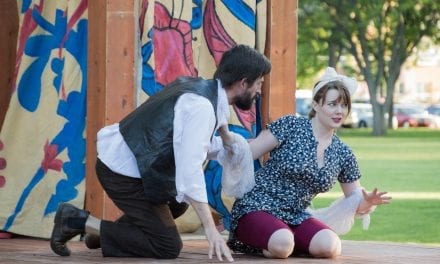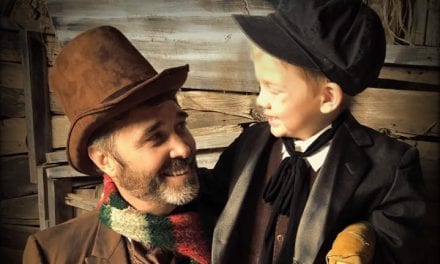OGDEN — Decades before the #MeToo movement, a group of Boston secretaries organized the “9to5 movement” in the 1970s to fight for better pay, more opportunities to advance, and to stop workplace sexual harassment. The movement lead to the comedy film, 9 to 5, which showed three secretaries, Dolly Parton alongside Jane Fonda and Lily Tomlin, having to navigate the misogyny of the American office in the 1980s. 9 to 5: The Musical is faithful to the movie, with book by the original screenwriter, Patricia Resnick. Parton herself wrote the music and lyrics for the musical and narrates the evening. The Ziegfeld Theater‘s version of this musical is funny and exciting, full of laugh-out-loud humor ranging from farce to witticism, innuendos to slapstick. It is written as an, “interoffice love letter,” to the women of the original movement and makes for an evening full of toe-tapping numbers as big as Parton’s hair and… business acumen.

Show closes September 4, 2021.
While the evening was wonderful and full of humor and excellent singing, I have to add two clauses to that statement. This play is PG13. It has language, smoking, drug use, alcoholism, sexual harassment, references to BDSM, and murderous fantasies. That said, it is not gratuitously offensive but rather hilarious and lighthearted about these issues. Patrons should just be aware it is a musical for a more mature audience.
The second clause I have to add is that the night was plagued by sound technical difficulties that will hopefully be resolved in later performances but were rather glaring on opening night. The opening cue of alarm clocks had two false starts before the third time was the charm and started the show.
Director Rebecca Knowles frames the musical to feel like a 70s sitcom, complete with commercial breaks projected during scene changes and a laugh track, which was funny most of the time, felt a little too forced at other times, but did have a consistent feel with the theme. Knowles also designed the set with Caleb Parry and gave it a fun technicolor vibe with the paint scheme and lights.
The musical revolves around three female leads who were all phenomenal in their performances. Parton’s self-parody character is Doralee Rhodes, played by Jordyn Aspyn, and is perfectly encapsulated in the number, “Backwoods Barbie,” explaining how she is always judged by her bra more than her brains. Aspyn as Doralee does a great job with the Tennessee dialect that Parton is known for and easily adopted many of the vocal tics of Parton’s country style while maintaining a warm tone.
New to the office of Consolidated Industries is recently divorced Judy Bernley, played by Clarissa Wykstra, who has to admit that she has no work experience. Judy has the biggest arc, starting the play as nervous, naïve, and dejected, but she finds her strength to be her own woman and stand on her own two feet. Wykstra’s rendition of, “Get Out and Stay Out,” was powerful and moving.
Judy could have been fired the moment they realized she has no work experience, but she is instead taken under the wing of Violet Newstead, played by Cate Conroy. Violet is a widow raising her son by herself and trying to climb the corporate ladder but is passed over for yet another promotion because she is a woman. Conroy has a strong voice, and she blended well with the other female leads on the songs they share but really shined brightly as a twisted Snow White in her solo song, “Potion Notion.” Conroy is a full triple threat as a strong actor, singer, and dancer with moves that really wow in her Busby Berkley style number, “One of the Boys,” where you can’t stop looking at her legs that go for days under the white suit jacket. The only number where Conroy struggled was in her duet, “Let Love Grow,” where the character allows herself to fall for her much younger colleague Joe, played by Cooper Lavallee. This number was the only number in the show that was really pitchy, had poor harmony, and had no chemistry between the actors.
Actor Eb Madson may have had the hardest job as an actor by playing Franklin Hart, Jr., the domineering and lecherous boss. Madson has a good voice, and his dancing is on par in each number, but Madson really shined with his excellent comic timing. Somehow, he makes being a, “sexist, lying, egotistical, hypocritical bigot,” laugh-out-loud funny and does a commendable job being the chauvinistic boss you love to hate.
While the sound issues were a problem, several technical elements really shined in this production. The costume design by Jennie Westfall does a great job setting the late 70s era with plenty of polyester. I particularly enjoyed the costumes in the drug-induced dream sequences. The demented Snow White as well as Judy’s femme fatal were delightful.
This musical is written to be as big and flashy as the Queen of Country, and choreographer Kacee Neff does a good job utilizing the space as well as the dancer’s individual talents. There were a few times that the large group numbers were slightly over-choreographed, and some actors were not able to keep up with the fierce pace, but all of the smaller numbers were very impressive. The ensemble cast does an exceptional job making their characters unique while being a unified chorus in both singing and dancing.
As I said, this show might not be a show for all theatre-goers, but it is a fun production for people who are ready to laugh and like a little twang thrown into their show-stopping numbers. The Ziegfeld set out to write an, “interoffice love letter,” and succeed in making a good memorandum that explores female empowerment in a way that is as relevant today as when it was set.




